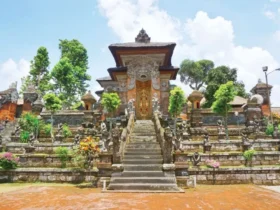Gatep Lawas Ambengan Bali

Gatep Lawas Ambengan Bali. Bali, with its rich cultural heritage, majestic temples, and stunning landscapes, never ceases to surprise travelers with its hidden treasures. Beyond the well-known tourist spots lies a Bali that is quieter, more traditional, and deeply connected to its natural surroundings. One such hidden gem is Gatep Lawas in Ambengan, a destination that embodies Bali’s blend of natural beauty and cultural richness.
Nestled in the tranquil village of Ambengan in North Bali, Gatep Lawas is an undiscovered spot that offers a mix of cultural history, natural splendor, and a serene escape from the hustle and bustle of the more tourist-heavy parts of the island. Surrounded by lush rice terraces, waterfalls, and verdant forests, Gatep Lawas is a place where visitors can experience the authentic and spiritual side of Bali.
Location of Gatep Lawas in Ambengan
Gatep Lawas is located in Ambengan Village, which is situated in the Buleleng Regency of North Bali. Ambengan is a peaceful village known for its natural beauty, including rice terraces, hidden waterfalls, and traditional Balinese culture that remains largely untouched by mass tourism. The village is located approximately 20 kilometers from Singaraja, the former capital of Bali, and is about a two-hour drive from Ubud or a three-hour drive from the popular tourist areas in South Bali.
The journey to Gatep Lawas takes visitors through scenic mountain roads, past traditional Balinese villages, and alongside terraced rice paddies that reflect the island’s agricultural heritage. The peacefulness of the area is a stark contrast to the more developed southern parts of Bali, making it the perfect place for those looking to experience the island’s quieter, more rural side.
The Meaning and History of Gatep Lawas

The name Gatep Lawas carries significant meaning in the local Balinese dialect. “Gatep” translates to “gate” or “doorway,” while “Lawas” means “ancient” or “old.” Thus, Gatep Lawas can be interpreted as “the ancient gateway,” symbolizing a connection between the past and present, as well as between the physical world and the spiritual realm.
Gatep Lawas is a site of historical and spiritual importance for the people of Ambengan. It serves as a sacred place of worship, where villagers come to perform traditional ceremonies and rituals, particularly during important Balinese Hindu festivals. The area around Gatep Lawas is dotted with small shrines, temples, and statues that are dedicated to the gods and spirits of Bali.
While Gatep Lawas may not be as large or famous as some of Bali’s more iconic temples, its significance lies in its connection to the local community and its preservation of ancient Balinese traditions. The site has been a place of worship for centuries, and its relatively remote location has helped it remain largely untouched by modern development, allowing it to retain its authentic spiritual atmosphere.
Exploring Gatep Lawas: A Journey into Bali’s Natural Beauty

What sets Gatep Lawas apart from other sacred sites in Bali is not only its spiritual importance but also its stunning natural surroundings. The village of Ambengan is known for its lush landscape, with rice terraces, jungle paths, and waterfalls that provide visitors with plenty of opportunities to explore Bali’s natural beauty.
One of the highlights of a visit to Gatep Lawas is the trek through the rice terraces and forests that lead to the site. The walk itself is an immersive experience, taking visitors through Bali’s iconic terraced fields, which are part of the island’s traditional subak irrigation system. This system, which has been in place for centuries, reflects the Balinese philosophy of Tri Hita Karana, or the balance between humans, nature, and the gods.
The rice terraces around Ambengan are particularly beautiful during the planting and growing seasons when the fields are a vibrant green and the terraces are filled with water, creating a mirror-like effect that reflects the sky and surrounding mountains. The sight of farmers working in the fields, planting or harvesting rice, adds to the authenticity of the experience and provides a glimpse into the traditional Balinese way of life.
As visitors approach Gatep Lawas, they are greeted by stone gates and ancient shrines, which blend seamlessly into the natural environment. The gates are adorned with traditional Balinese carvings, depicting mythological creatures, gods, and sacred symbols. The stone steps leading up to the shrines are often covered in moss, adding to the sense of ancient mysticism that permeates the area.
Waterfalls near Gatep Lawas
Another major attraction near Gatep Lawas is the presence of several stunning waterfalls, which are tucked away in the surrounding jungle. The most famous waterfall in the area is Jemeluk Waterfall, located just a short distance from Gatep Lawas. The waterfall cascades down from a height of around 15 meters, creating a cool, refreshing pool at its base that is perfect for swimming.
The waterfalls of Ambengan are known for their beauty and tranquility, and unlike some of the more famous waterfalls in Bali, they remain largely undiscovered by tourists, allowing visitors to enjoy the peaceful surroundings in relative solitude. The sound of the rushing water, combined with the lush greenery of the jungle, creates a serene atmosphere that is ideal for relaxation and meditation.
For those seeking adventure, there are several other smaller waterfalls in the area that can be reached by hiking through the jungle. These hidden gems are often surrounded by dense foliage and offer a more secluded experience, making them perfect for nature lovers who want to escape the crowds.
Cultural and Spiritual Activities at Gatep Lawas
Gatep Lawas is not just a place for sightseeing—it is also a living, breathing spiritual site where traditional Balinese rituals and ceremonies are still performed by the local community. Visitors who come to Gatep Lawas have the opportunity to witness these ceremonies, which often involve offerings, prayers, and the chanting of mantras by the local priests.
One of the most important ceremonies held at Gatep Lawas is the Piodalan, which is the temple’s anniversary celebration. During this time, villagers come to the site to offer prayers and offerings to the gods, seeking blessings for fertility, health, and prosperity. The Piodalan festival at Gatep Lawas is a colorful and lively event, with traditional gamelan music, dance performances, and processions that showcase the rich cultural heritage of the Balinese people.
Visitors are welcome to observe these ceremonies, but it is important to be respectful and mindful of the sacred nature of the site. Wearing a sarong and sash is required when entering the temple grounds, and these can often be borrowed from the temple or purchased at nearby shops.
How to Visit Gatep Lawas and What to Expect
Visiting Gatep Lawas requires a bit of planning, as the site is located in a relatively remote area of Bali. Most visitors reach the village of Ambengan by hiring a private car or scooter from Singaraja, Lovina, or Ubud. The drive to Ambengan offers stunning views of Bali’s northern mountains and coastal plains, making the journey itself an enjoyable part of the experience.
Upon arrival in Ambengan, visitors can explore the village’s traditional houses, many of which are still built in the traditional Balinese style. From the village, it’s a short trek through the rice fields and jungle to reach Gatep Lawas. The walk is relatively easy and suitable for most fitness levels, but it’s a good idea to wear comfortable shoes and bring plenty of water, especially if visiting during the warmer months.
Once at Gatep Lawas, visitors can spend time exploring the temple grounds, enjoying the peaceful atmosphere, and taking in the natural beauty of the area. For those interested in photography, Gatep Lawas offers countless opportunities to capture stunning images of Bali’s landscape, from the terraced rice fields to the waterfalls and jungle paths.
Best Time to Visit Gatep Lawas
The best time to visit Gatep Lawas is during the dry season, which runs from April to October. During this time, the weather is more predictable, with clear skies and cooler temperatures that make exploring the rice terraces and jungle trails more enjoyable. The rainy season, from November to March, can bring heavy downpours and muddy conditions, which may make the trek to Gatep Lawas more challenging.
However, for those looking to experience Bali’s cultural festivals, the Piodalan festival at Gatep Lawas is an excellent time to visit. The exact date of the festival varies according to the Balinese Pawukon calendar, so it’s a good idea to check in advance if you’re interested in attending the temple’s anniversary celebration.
Conclusion
Gatep Lawas in Ambengan is one of Bali’s hidden gems, offering visitors a unique opportunity to explore the island’s rich cultural heritage and stunning natural beauty. Tucked away in the peaceful village of Ambengan, Gatep Lawas is a place where the past meets the present, and where the spiritual and natural worlds come together in perfect harmony.
For travelers seeking an authentic and off-the-beaten-path experience, a visit to Gatep Lawas provides a glimpse into the traditional life of Bali’s rural communities, as well as the chance to witness the island’s deep spiritual traditions firsthand. Whether you’re exploring the terraced rice fields, swimming in the nearby waterfalls, or simply soaking in the peaceful atmosphere of the temple, Gatep Lawas is a destination that will leave you with a deeper appreciation for the beauty and spirituality of Bali.










Leave a Review